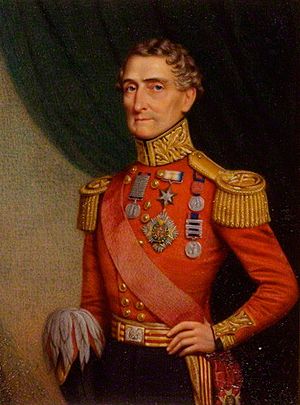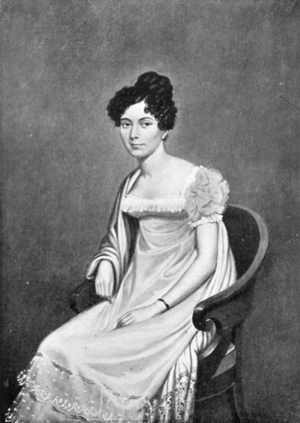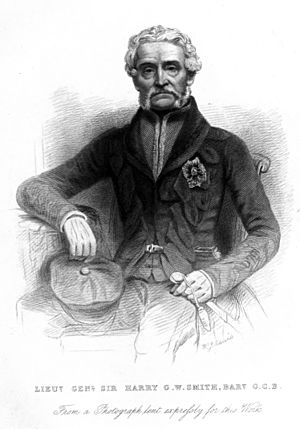Sir Harry Smith, 1st Baronet facts for kids
Quick facts for kids
Sir Harry Smith, Bt
|
|
|---|---|
 |
|
| Born | 28 June 1787 Whittlesey, Cambridgeshire, Great Britain |
| Died | 12 October 1860 (aged 73) London, United Kingdom |
| Allegiance | |
| Service/ |
|
| Years of service | 1805 - 1859 |
| Rank | Lieutenant-General |
| Commands held | Western District Northern District |
| Battles/wars | Napoleonic Wars War of 1812 Xhosa Wars Gwalior campaign First Anglo-Sikh War Battle of Boomplaats |
| Awards | Knight Grand Cross of the Order of the Bath |
| Spouse(s) | Juana María de los Dolores de León Smith (married 1812) |
Lieutenant-General Sir Henry George Wakelyn Smith (born June 28, 1787 – died October 12, 1860) was an important English soldier. He was a military leader in the British Army during the early 1800s. He fought in the Napoleonic Wars and is also remembered for his role in the Battle of Aliwal in India in 1846. Later, he became the governor of the Cape Colony in South Africa. He was married to Lady Smith.
Today, the town of Harrismith in South Africa is named after him. It's a well-known stop between Johannesburg and Durban.
Contents
About Harry Smith
Harry Smith was born in Whittlesey, England. His father was a surgeon and a military major. Harry went to school in a chapel at St. Mary’s church in his hometown. A general named Stewart noticed Harry and helped him get a job as a second lieutenant in the 95th Rifle Regiment. Later, in 1862, a part of St. Mary's church was fixed up in his memory. A local school, Sir Harry Smith Community College, is also named after him.
Fighting in Europe: The Napoleonic Wars
Harry Smith began his military career on May 8, 1805. He was promoted to Lieutenant on August 15. His first time fighting was in South America in 1806. He showed great bravery at the Battle of Montevideo in 1807.
He became well-known during the Peninsular War (1808-1814). This was a big part of the Napoleonic Wars in Spain and Portugal. Harry Smith served with the 95th Rifles throughout these battles. In 1812, he became a Captain.
After the storming of Badajoz in Spain, Harry met a young Spanish lady named Juana Maria de Los Dolores de León. She was only fourteen but had lost everything in the city. Harry married her a few days later. Juana traveled with him for the rest of the war.
After the war in Europe, Harry Smith volunteered to fight in the United States. He was at the Battle of Bladensburg in 1814. He also saw the burning of the capital building in Washington D.C.. He said this "horrified" him because it was so different from the way the Duke of Wellington fought in France.
When he returned to Europe, he was a major at the Battle of Waterloo in 1815. This was a very famous battle where Napoleon was finally defeated. After the war, he helped manage the city of Cambray in France. Later, he returned to Scotland.
Service in South Africa: The Xhosa Wars
By the end of 1826, Harry Smith was promoted to Major. In 1828, he was sent to the Cape of Good Hope in South Africa. He led troops in the Sixth Xhosa War (1834-1836). In 1835, he rode 550 miles from Cape Town to Grahamstown in less than six days! This was a huge achievement.
He helped bring back confidence among the white settlers. He was made governor of the Province of Queen Adelaide. He worked hard to help the local tribes and gained their trust. However, the government in London disagreed with his plans. They decided to change his policy. Harry Smith was removed from his command. Both the local Bantu people and the Boers (Dutch settlers) were sad to see him go. Many Boers then moved further inland in what was called the Great Trek.
Fighting in India
In 1840, Smith was sent to India. He took part in the Gwalior campaign in 1843. For his bravery, he was given an award called the Knight Commander of the Order of the Bath (KCB). From 1845 to 1846, he fought in the First Anglo-Sikh War.
He led a group of soldiers in the battles of Mudki and Ferozeshah. He showed great courage in these battles. After these fights, Smith was given his own command. On January 28, 1846, he led his troops to a big victory against the Sikhs at Aliwal.
He also commanded a group at the Battle of Sobraon on February 10. For his great victory at Aliwal, the British Parliament thanked him. The Duke of Wellington, a very famous general, praised him highly. Smith was also made a baronet, which is a special title. As a special honor, the words "of Aliwal" were added to his title. He was promoted to Major-General on November 9, 1846.
Return to South Africa
In 1847, Harry Smith returned to South Africa. He became the Governor of Cape Colony and a high commissioner. He had to deal with problems he had seen coming years before. He led an expedition to deal with some unhappy Boers. He fought the Battle of Boomplaats on August 29, 1848.
In December 1850, another war started with the Xhosa and some Khoikhoi groups. Harry Smith did not have enough soldiers from England. Even though other military leaders praised his actions, he was called back to England in 1852. He strongly disagreed with giving up the Orange River Sovereignty to the Boers, which happened two years after he left. He also supported giving more self-governance to the Cape Colony.
His wife, Juana, had two towns named after her: Ladysmith in KwaZulu-Natal and Ladismith in the Western Cape. Harrismith in the Free State was named after Harry Smith himself. Two other towns, Aliwal North and Smithfield, also show his connection to South Africa.
Smith was impressed by the soldiers of the Cape Mounted Riflemen. He created Sir Harry Smith's Medal for Gallantry to recognize their bravery.
Later Life in England
In 1853, he became the General Officer Commanding the Western District back in England. He was promoted to lieutenant-general on June 20, 1854. In 1856, he was appointed to lead the Northern District.
After a long illness, Harry Smith passed away at his home in London on October 12, 1860. He was buried at St Mary's church in Whittlesey. There is a marble statue and memorial there to remember him. That part of the church is now called Sir Harry's Chapel. His wife, Juana, who died on October 10, 1872, is buried with him.
His autobiography, which is his life story written by himself, was published after he died in 1901. It is considered a classic book about love and war.
The story of Harry Smith and his wife during the Peninsular Campaign and the Battle of Waterloo is told in Georgette Heyer's novel The Spanish Bride (1940).




